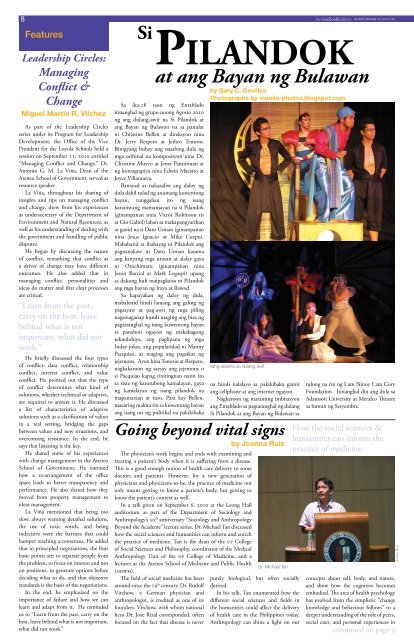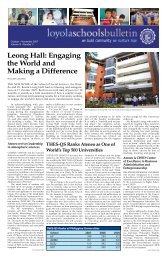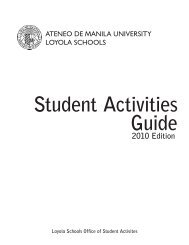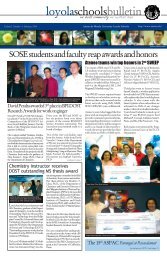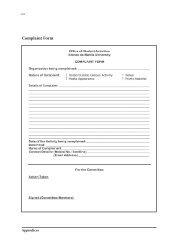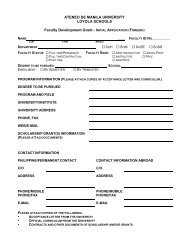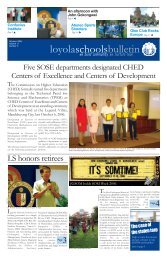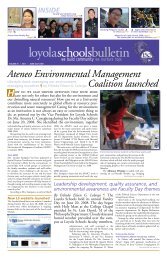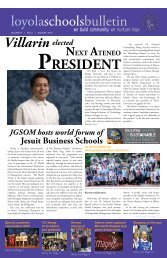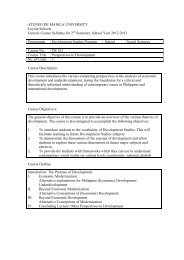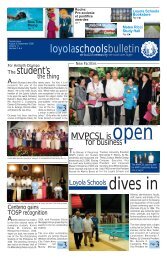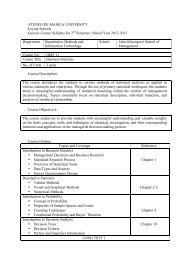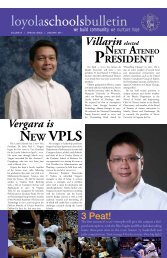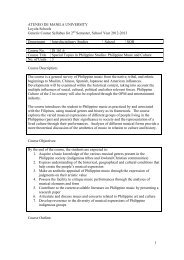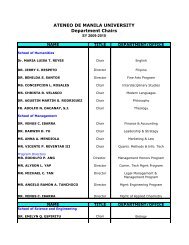ORO, & DAVAO - Ateneo de Manila University
ORO, & DAVAO - Ateneo de Manila University
ORO, & DAVAO - Ateneo de Manila University
You also want an ePaper? Increase the reach of your titles
YUMPU automatically turns print PDFs into web optimized ePapers that Google loves.
8<br />
loyolaschoolsbulletin<br />
we build community we nurture hope<br />
Si<br />
Features<br />
Pilandok<br />
Lea<strong>de</strong>rship Circles:<br />
Managing<br />
Conflict &<br />
Change<br />
Miguel Martin R. Vilchez<br />
As part of the Lea<strong>de</strong>rship Circles<br />
series un<strong>de</strong>r its Program for Lea<strong>de</strong>rship<br />
Development, the Office of the Vice<br />
Presi<strong>de</strong>nt for the Loyola Schools held a<br />
session on September 13, 2010 entitled<br />
“Managing Conflict and Change.” Dr.<br />
Antonio G. M. La Viña, Dean of the<br />
<strong>Ateneo</strong> School of Government, served as<br />
resource speaker.<br />
La Viña, throughout his sharing of<br />
insights and tips on managing conflict<br />
and change, drew from his experiences<br />
as un<strong>de</strong>rsecretary of the Department of<br />
Environment and Natural Resources, as<br />
well as his un<strong>de</strong>rstanding of <strong>de</strong>aling with<br />
the government and handling of public<br />
disputes.<br />
He began by discussing the nature<br />
of conflict, remarking that conflict as<br />
a driver of change may have different<br />
outcomes. He also ad<strong>de</strong>d that in<br />
managing conflict, personalities and<br />
i<strong>de</strong>as do matter and that clear processes<br />
are critical.<br />
“Learn from the past,<br />
carry on the best, leave<br />
behind what is not<br />
important, what did not<br />
work.”<br />
He briefly discussed the four types<br />
of conflict: data conflict, relationship<br />
conflict, interest conflict, and value<br />
conflict. He pointed out that the type<br />
of conflict <strong>de</strong>termines what kind of<br />
solutions, whether technical or adaptive,<br />
are required to answer it. He discussed<br />
a list of characteristics of adaptive<br />
solutions such as a clarification of values<br />
in a real setting, bridging the gaps<br />
between values and new situations, and<br />
overcoming resistance. In the end, he<br />
says that listening is the key.<br />
He shared some of his experiences<br />
with change management in the <strong>Ateneo</strong><br />
School of Government. He narrated<br />
how a re-arrangement of the office<br />
space leads to better transparency and<br />
performance. He also shared how they<br />
moved from property management to<br />
i<strong>de</strong>as management.<br />
La Viña mentioned that being too<br />
slow, always wanting <strong>de</strong>tailed solutions,<br />
the use of toxic words, and being<br />
in<strong>de</strong>cisive were the barriers that could<br />
hamper reaching a consensus. He ad<strong>de</strong>d<br />
that in principled negotiations, the four<br />
basic points are: to separate people from<br />
the problem, to focus on interest and not<br />
on positions, to generate options before<br />
<strong>de</strong>ciding what to do, and that objective<br />
standards is the basis of the negotiations.<br />
In the end, he emphasized on the<br />
importance of failure and how we can<br />
learn and adapt from it. He remin<strong>de</strong>d<br />
us to “Learn from the past, carry on the<br />
best, leave behind what is not important,<br />
what did not work.”<br />
at ang Bayan ng Bulawan<br />
by Gary C. Devilles<br />
Sa ika-28 taon ng Entablado<br />
itinanghal ng grupo noong Agosto 2010<br />
ng ang dulang-awit na Si Pilandok at<br />
ang Bayan ng Bulawan na sa panulat<br />
ni Christine Bellen at direksyon nina<br />
Dr. Jerry Respeto at Jethro Tenorio.<br />
Binigyang buhay ang nasabing dula ng<br />
mga orihinal na komposisyon nina Dr.<br />
Christine Muyco at Jema Pamintuan at<br />
ng koreograpiya nina Edwin Maestro at<br />
Joyce Villanueva.<br />
Banayad at nakaaaliw ang daloy ng<br />
dula dahil tulad ng anumang kuwentong<br />
bayan, tunggalian ito ng isang<br />
karaniwang mamamayan na si Pilandok<br />
(ginampanan nina Victor Robinson iii<br />
at Gio Gahol) laban sa makapangyarihan<br />
at ganid na si Datu Usman (ginampanan<br />
nina Jesus Ignacio at Mike Cuepo).<br />
Mababatid at ihahayag ni Pilandok ang<br />
pagnanakaw ni Datu Usman kasama<br />
ang kanyang mga utusan at alalay gaya<br />
ni Orochimaru (ginampanan nina<br />
Jason Barcial at Mark Legaspi) upang<br />
sa dakong huli maipagkaisa ni Pilandok<br />
ang mga bayan ng Iraya at Ilawod.<br />
Sa kapayakan ng daloy ng dula,<br />
mababatid hindi lamang ang galing ng<br />
pagsayaw at pag-awit ng mga piling<br />
nagsinaganap kundi maging ang bisa ng<br />
pagtatanghal ng isang kuwentong bayan<br />
sa panahon ngayon ng makabagong<br />
teknolohiya, ang paglipana ng mga<br />
Inday jokes, ang popularidad ni Manny<br />
Pacquiao, at maging ang pagsikat ng<br />
jejemons. Ayon kina Tenorio at Respeto,<br />
nagkakaroon ng saysay ang jejemons o<br />
si Pacquiao kapag tinitingnan natin ito<br />
sa siste ng katutubong kamalayan, gaya<br />
ng kamalayan ng isang pilandok na<br />
mapamaraan at tuso. Para kay Bellen,<br />
maaaring makita rin sa kuwentong bayan<br />
ang isang uri ng pulitikal na pakikibaka<br />
Photographs by manila-photos.blogspot.com<br />
na hindi nalalayo sa pakikibaka gamit<br />
ang cellphone at ang internet ngayon.<br />
Nagkaroon ng maraming imbitasyon<br />
ang Entablado sa pagtatanghal ng dulang<br />
Si Pilandok at ang Bayan ng Bulawan sa<br />
Going beyond vital signs<br />
The physician’s work begins and ends with examining and<br />
treating a patient’s body when it is suffering from a disease.<br />
This is a good enough notion of health care <strong>de</strong>livery to some<br />
doctors and patients. However, for a new generation of<br />
physicians and physicians-to-be, the practice of medicine not<br />
only means getting to know a patient’s body, but getting to<br />
know the patient’s context as well.<br />
In a talk given on September 6, 2010 at the Leong Hall<br />
auditorium as part of the Department of Sociology and<br />
Anthropology’s 50 th anniversary “Sociology and Anthropology<br />
Beyond the Aca<strong>de</strong>me” lecture series, Dr. Michael Tan discussed<br />
how the social sciences and humanities can inform and enrich<br />
the practice of medicine. Tan is the <strong>de</strong>an of the up College<br />
of Social Sciences and Philosophy, coordinator of the Medical<br />
Anthropology Unit of the up College of Medicine, and a<br />
lecturer at the <strong>Ateneo</strong> School of Medicine and Public Health<br />
(asmph).<br />
The field of social medicine has been<br />
around since the 19 th century. Dr. Rudolf<br />
Virchow, a German physician and<br />
anthropologist, is credited as one of its<br />
foun<strong>de</strong>rs. Virchow, with whom national<br />
hero Dr. Jose Rizal correspon<strong>de</strong>d, often<br />
focused on the fact that disease is never<br />
Ilang eksena sa dulang-awit<br />
by Joanna Ruiz<br />
Dr. Michael Tan<br />
purely biological, but often socially<br />
<strong>de</strong>rived.<br />
In his talk, Tan enumerated how the<br />
different social sciences and fields in<br />
the humanities could affect the <strong>de</strong>livery<br />
of health care in the Philippines today.<br />
Anthropology can shine a light on our<br />
tulong na rin ng I am Ninoy I am Cory<br />
Foundation. Itinanghal din ang dula sa<br />
Adamson <strong>University</strong> at Meralco Theatre<br />
sa buwan ng Setyembre.<br />
How the social sciences &<br />
humanities can inform the<br />
practice of medicine<br />
concepts about self, body, and nature,<br />
and show how the cognitive becomes<br />
embodied. The area of health psychology<br />
has evolved from the simplistic “change<br />
knowledge and behaviour follows” to a<br />
<strong>de</strong>eper un<strong>de</strong>rstanding of the role of peers,<br />
social cues, and personal experiences in<br />
continued on page 9<br />
Joanna Ruiz


